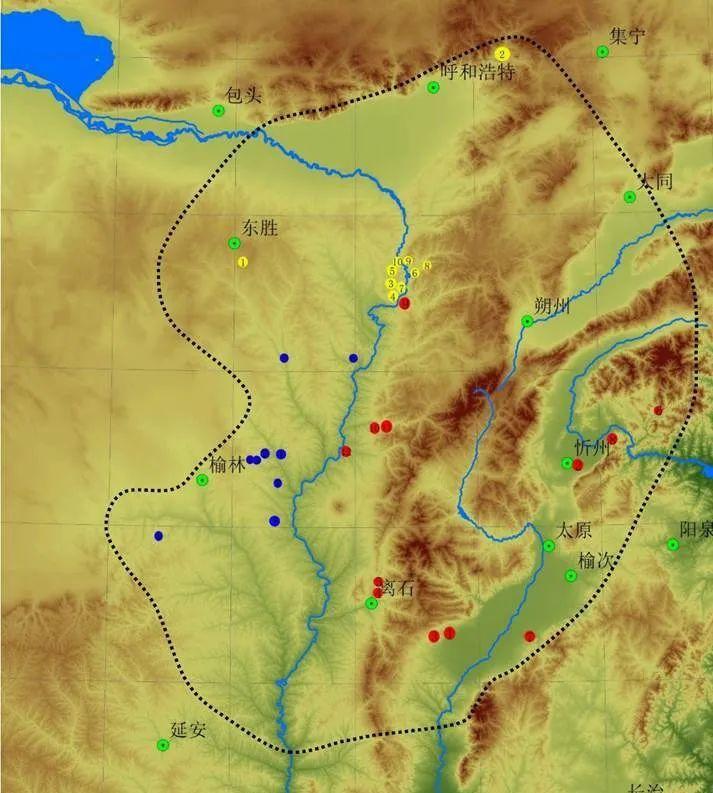As the saying goes, "the talented son of the south, the general of the north, the loess of Shaanxi buried the emperor." As a major province of cultural relics, Shaanxi has a long history and many cultural relics. In 2020 alone, Shaanxi carried out 179 archaeological projects of various types, excavating 3,956 ancient tombs and 105,800 square meters of ancient ruins.
In January 2021, the results of the selection of "The First Six New Archaeological Discoveries in Shaanxi in 2020" were announced. In order to bring the archaeological project into the public eye and help people understand the archaeological work. Starting today, we will launch a series of reports to tell you the mysterious story behind these six new archaeological discoveries.
The first article "Yulin Province Guzhaishan Ruins - The Hierarchy May Start Here"
Located in Fugu County, Yulin City, at the junction of Shaanxi, Shanxi and Inner Mongolia provinces (districts), about 60 kilometers northeast of the Shenmu Shi'an site, the Fugu Zhaishan Ruins are a secondary settlement of the Shi'an culture.
The main connotation of the Shenmu Shi'an site is a stone masonry city site dating back about 4,000 years, which is a super-large central settlement from the late Longshan Period to the early Xia Dynasty in northern China.

The geographical scope of the Shi'an culture
Shao Jing, research librarian of Shaanxi Archaeological Research Institute
Shao Jing, research librarian of Shaanxi Archaeological Research Institute: "Why do you want to excavate Zhaishan and study Zhaishan?" Zhaishan and Shiya are inseparable. Since 2011, we have been working on archaeology in Shi'an for 10 consecutive years, formally proposing the Shi'an culture and the Shi'an Kingdom behind it. The Fugu ZhaiShan Shicheng is a second- or third-level settlement under the core position of Shiya. ”
The discovery and preliminary confirmation of Zhaishan Shicheng was in 2015. The "Gaotai Base Site" found at the temple site in the northern part of the city is similar in nature to the Shi'an Imperial City Terrace and may be the "core area" of Zhaishan Stone City. After excavation, at present, Zhaishan Stone City has cleaned up more than 20 Tombs of Shi'a culture, and unearthed a variety of burial items such as jade and pottery. According to the funeral utensils, niches and martyrdom, it can be divided into four categories.
2020M4 Right Hand Jade
Shao Jing: "The first category has martyrs, niches, and tomb coffins; the second category, there are no martyrs, niches, and tomb coffins; the third category, there are no martyrs, no niches, and there are tomb coffins; the fourth category, there are three none." The size of these tombs, from one to four, changed from large to small. Therefore, the Zhaishan cemetery can reflect the difference in rank. ”
In addition to the difference in tomb form system, the burial items and martyrdom of the highest level of tombs also reflect the funerary system and hierarchical consciousness under the early state form in northern China 4,000 years ago.
Shao Jing: "The first type of tomb, the owner of the tomb has more jade buried in the tomb coffin, the most important thing is to find a triangular jade piece in the mouth, and a cymbal-shaped jade ornament found in the right hand, which should be found earlier in the mouth and hand. This woman was martyred, and was treated very violently before she died, and then buried as a martyr. ”
Zhaishan site 2020M4 niches and funerary artifacts
All these provide important burial materials for studying the origin, development patterns and processes of the early Chinese state. At the same time, as a secondary settlement of Shi'an, it also makes up for the major shortcomings of the serious excavation of the Shi'a site.
Shao Jing, research librarian of the Shaanxi Archaeological Research Institute: "The four types of tombs should represent people of different levels of identity, which is also a very important material for studying the origin of the country and the origin of civilization. These tombs are not isolated, and together they construct the basic framework of the Shi'a culture tombs, which is an important archaeological material for the study of settlements and societies in the Hetao region, reflecting the hierarchical consciousness and funerary etiquette in the early state forms in northern China 4,000 years ago. ”
2020M4 niches and funerary utensils
Zhang Hongyan, a professor at the School of Cultural Heritage of Northwest University, introduced that the origin of Chinese civilization is one of the most important academic topics in the academic community in the past decade or so, and the elements of civilization are often produced in the prehistoric period. The discovery of Shi'an is a groundbreaking stone, and the discovery and excavation of the Zhaishan site proves that the Shi'an culture is a complex society composed of a multi-level management system. At the same time, adults move from equality to inequality.
Zhang Hongyan, a professor at the School of Cultural Heritage of Northwest University, said: "These two points show that the Shi'an culture has departed from the simple or equal society state of prehistoric culture and entered a complex society and an unequal society. It can even be said that it has stepped into the threshold of civilization. Therefore, the excavation of the Zhaishan site has played such an important role in carrying forward the upper and lower levels, and in Chinese prehistoric archaeology, for the first time, archaeological excavations have proved the existence of such a multi-level management system and the existence of an unequal society. ”
Producer: Recreation Group
Editor-in-charge: Wu Wei
Reporter: Lin Yan
Edit: Tuo Ziyun
Reprinted from: Listen to Shaanxi
Original title: The Story of Revealing the Remains of Cultural Relics (1) | Yulin Province Guzhaishan Ruins: The hierarchy may start here